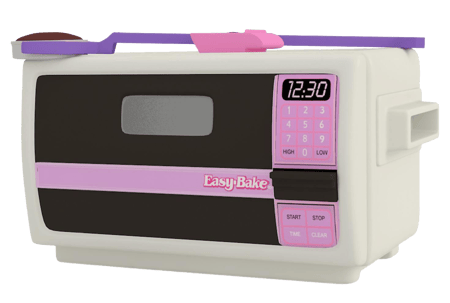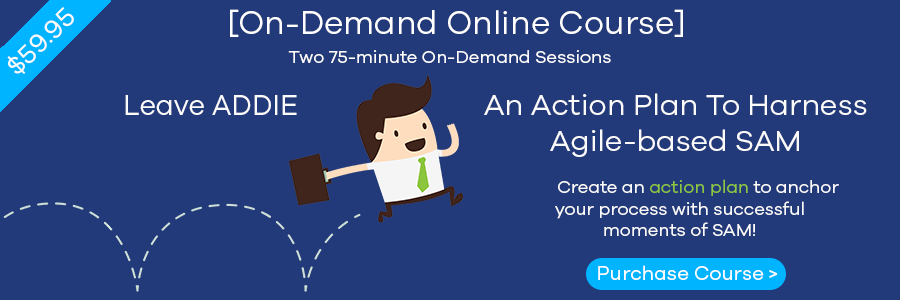Blog
Five Tips to Battle E-Learning Project Constraints
By Edmond Manning, Senior Instructional Strategist "I don't have a spring-form pan. Can I use a regular cake pan for this raspberry truffle ...


Using an Iterative Process to Bake Successful e-Learning Results
By Edmond Manning | May 25, 2016 | Custom Learning | 0 Comments
By Edmond Manning, Senior Instructional Strategist
 "I don't have a spring-form pan. Can I use a regular cake pan for this raspberry truffle cheesecake?" – TV show host to guest chef, HGTV
"I don't have a spring-form pan. Can I use a regular cake pan for this raspberry truffle cheesecake?" – TV show host to guest chef, HGTV
I saw this question asked on television one Saturday afternoon.
One might argue that this TV show host didn't ask me this question directly. One might even argue that the question is not related to e-learning. Yes, one might make this case.
However, I hear this question all the time in different flavors (and I’m not talking about blueberry or raspberry truffle). Here's a sampling:
"I love your design ideas, but my company won't let us do anything interactive. How do I take your ideas and integrate them into .pdf files?"
"I really *get* instructional interactivity. How do we integrate more drag-and-drops into our training?"
"I like what you say about motivation, but since they would never let us address that directly, how do I achieve behavioral change without incorporating this element?"
The answer to all three questions is the same: your e-learning (much like the aforementioned cheesecake produced in a cake pan) ain’t gonna come out right.
Sorry.
 It's not enough to have the recipe. Yes, that's a critical start to producing amazing e-learning: understanding the ingredients, keeping those skills fresh, and creating new recipes for success. But you can't create Baked Alaska in an Easy-Bake-Oven. The process is just as important as the recipe.
It's not enough to have the recipe. Yes, that's a critical start to producing amazing e-learning: understanding the ingredients, keeping those skills fresh, and creating new recipes for success. But you can't create Baked Alaska in an Easy-Bake-Oven. The process is just as important as the recipe.
Successive approximation (SAM) works for the design and development of e-learning because it is practical and manageable. It also double-checks assumptions, promotes creativity, communicates effectively, involves all key stakeholders, and aligns solutions to needs. That's a lot. But at its heart, SAM is a very simple, iterative process that's repeatedly applied to a carefully-defined sequence of issues.
The process is divided into three phases: Preparation, Iterative Design, and Iterative Development. Iterative cycles are used both in design and development work to confirm the desirability of what was done and to make corrections. Changes are expected with decreasing significance and frequency.
Preparation
Quality is best attained by planning for it at the beginning. You start with Preparation. You focus on performance.
For example, for product courses, I often see the performance objectives (if they exist at all) centered around the salesperson “knowing” the features and benefits. Or—if the instructional designer is savvy to action-oriented verbs—it’s “Articulate the features and benefits.”
This project goal is fine if the salesperson is going to be called on to stand up in a crowded room and start listing all features and benefits. But that’s not how selling works.
More likely: the seller must tailor two or three features/benefits to the customer who reluctantly provides a forty-five second window of opportunity. And this seller must be able to articulate them in a way that doesn’t sound like they’re reading from a training manual. Therefore, the goal uncovered here is much different from a standard “articulate the benefits…”
If your preparation doesn’t uncover the details of how, when, and with whom this skill is to be deployed, the best recipe for e-learning will fail. Preparation is a critical time for sharping the desired outcome.
Iterative Design
Iterative design does something that real-world baking cannot: start over. If you’re making lasagna and decide, right before popping it into the oven, that it would be more fun to make mini-lasagnas in cupcake tins, it’s too late. You can’t waste the ingredients; you’ve invested too much already. During iterative design, it’s easy to scrap ideas and start over. In fact, the less investment in initial prototypes, the better.
 We prototype to give life to an idea, a concept. We do the minimum prototyping necessary so it’s easy to discard the idea if it’s not working out. Even if the prototyped idea is great, you should STILL discard it (at least temporarily) while you continue to hunt for the BEST ideas available. This attitude toward disposability is a key part of the process.
We prototype to give life to an idea, a concept. We do the minimum prototyping necessary so it’s easy to discard the idea if it’s not working out. Even if the prototyped idea is great, you should STILL discard it (at least temporarily) while you continue to hunt for the BEST ideas available. This attitude toward disposability is a key part of the process.
If you build attractive, fully-functional prototypes meant to impress stakeholders, you’re screwed. They get attached to whatever you present. They want to see progress (defined by good media or full functionality). To them, “disposable” is the very opposite of progress. As a consultant for the past 17 years, I fully understand the need to work within stakeholder constraints. It’s hard when your process is dictated by stakeholders, not best practices.
But again, the process matters.
Could you imagine a cooking show where the audience got to yell out what they wanted to see happen?
“TAKE IT OUT OF THE OVEN NOW, YOU JERK!”
“I SAID ADD A PINCH OF OREGANO, NOT A QUARTER TEASPOON – A PINCH!”
One of the training industry’s wacky quirks is that we often allow stakeholders non-skilled in training development to make decisions over timelines and budgets. Why?
Well…they have the money.
I understand that. But if you can’t convince them to hand over the decision-making reigns to those who know better, you better get really skilled at winning them over to good instructional design ideas. Prototypes can help you do that.
Development
Development locks in the creativity of the Design phase. Because multiple approaches and ideas were explored back when it was disposable and cheap, you’re less likely to encounter ideas that disrupt the entire process.
While the iterative design cycles are very fast, over a period of a few days or less, iterative development cycles may take much longer. This corresponds to the increasing certainty with which team members know what they want and are less and less likely to be making fundamental mistakes or missing precious opportunities.
Because of the time spent focusing on behavior and performance statements, there’s less “content anxiety” that typically occurs toward the end of the project. You know what I mean: on a content-driven project, a worried stakeholder wants to throw in “more” because he or she suddenly realizes there’s no guarantee of changed performance. Therefore, “more” equals “better training.”
Ugh.
Because of thorough preparation and a design phase where you’ve focused on uncovering the BEST ideas, stakeholders are less likely to worry during the development phase.
…And serve
This was just an overview of the SAM process. There are certainly more details and explanations absolutely critical on how to create this fabulous feast of e-learning.
So, yes, HGTV TV show host, you need a spring-pan. The tools and process matter as much as a good recipe.
LIKE WHAT YOU'VE READ? SHARE THE KNOWLEDGE WITH YOUR PEERS USING THIS READY-MADE TWEET!
 CLICK TO TWEET: Using an #IterativeProcess to Bake Successful #eLearning Results http://hubs.ly/H035J_m0 #aiblog
CLICK TO TWEET: Using an #IterativeProcess to Bake Successful #eLearning Results http://hubs.ly/H035J_m0 #aiblog

About the Author: Edmond Manning
Edmond Manning, senior instructional designer for Allen Interactions, has more than 20 years designing interactive e-learning experiences on instructional topics including: software simulation, medical ethics, supervisory skills, and selling/presentation skills, and gosh, a whole bunch of others. He has helped mentor and grow e-learning departments, worked as a business consultant, independent contractor, and instructed the ATD e-Learning Instructional Design Certificate Program for more than a decade. Edmond has a master's degree from Northern Illinois University in instructional technology.
Comments
Would you like to leave a comment?
Related Blog Posts

By: Edmond Manning | Sep, 2015
Category: Custom Learning

Blog
Hold the Phone (training)—5 Questions to Ask First
By Edmond Manning, Senior Instructional Strategist "I don't have a spring-form pan. Can I use a regular cake pan for this raspberry truffle ...
By: Edmond Manning | Dec, 2015
Category: Custom Learning

Blog
Once, When I was at Band Camp…
By Edmond Manning, Senior Instructional Strategist "I don't have a spring-form pan. Can I use a regular cake pan for this raspberry truffle ...
By: Edmond Manning | May, 2016
Category: Custom Learning

